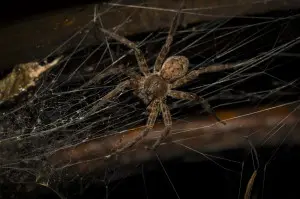There are about 200 different species of wolf spiders. The vast majority are between one-half and one inch in length. Often their colored, fur-like appearance closely resembles their natural environment of browns and greens, and they usually have strong dark and light contrasting colors. Wolf spiders have excellent eyesight for hunting their prey. Their bite, while it may be painful, is not known to pose any health risk.
The female wolf spider carries her hatched brood of spiderlings with her. A mother wolf spider with a dozen or more kids hitch-hiking on her back may look much larger than she is. She feeds the crew for a couple of days after birth, until they are large enough to hop off her back and go search for their own food. It’s usually after the teenage spiders start exploring on their own, possibly inside your house, that the wolf spider population becomes a nuisance. Generally, regular pest control services to treat the perimeter of your home will keep wolf spiders outside in the garden—where they can feast on all the bugs that eat our flowers, fruits, and vegetables rather than moving in with us and our families.

We’ve all seen them scurrying around the house. Wolf spiders, with their long legs and…
Read MoreCorporate Office
3499 Business Drive, Sacramento, CA 95820
916-381-5793
East Bay 1320 Willow Pass Rd Ste
#600, Concord, CA 94520
925-574-1706
428 Vernon St #101
Roseville, CA 95678
916-226-1836
1313 W Robinhood Dr a3
Stockton, CA 95207
209-323-2415
